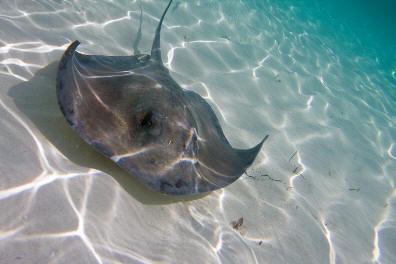Southern Stingray
(Dasyatis americana)
Southern Stingray Classification
Domain- Eukarya
Kingdom- Anamalia
Phylum- Chordata
Class- Chondrichthyes
Order- Myliobatiformes
Family- Dasyatidae
Genus- Dasyatis
Species- Dasyatis americana
*Domain- Southern Stingrays are in
the domain EUKARYA
because they are multicellular, have membrane bound organelles,
and have genetic material inside the nucleus.
*Kingdom- Southern Stingrays are in the kingdom
ANAMALIA because they
are heterotrophic, lack cell walls, and they are motile at
some stage of their life cycle.
*Phylum- Southern Stingrays are a part of the phylum CHORDATA because they have bilateral symmetry, a complete digestive tract, a segmented body, and a coelom. An animal in this phylum also has the following five unique characteristics: a notochord, a dorsal nerve chord, a post anal tail, an endostyle and pharyngeal pouches.
*Class- Southern Stingrays are a part of the class CHONDRICHTHEYES because they are vertebrates, have cartilaginous skeletons and have true jaws. Other organisms that belong to this class include: Great White Sharks, Bull Sharks, Blue-Spotted Stingrays, and Manta Rays.
*Order- Southern Stingrays are a
part of the order MYLIOBATIFORMS because this order includes the rays that
have the venomous spine that gives them the name stingray.
Members of this order are
ovoviviparous
and have a pelvic fin with one lobe.
MYLIOBATIFORMS because this order includes the rays that
have the venomous spine that gives them the name stingray.
Members of this order are
ovoviviparous
and have a pelvic fin with one lobe.
*Family- Southern Stingrays are a part of the family DASYATIDAE because this family includes the stingrays that have a whiptail.
*Genus- Southern Stingrays are a part of the genus DASYATIS. To find the meaning of this genus, you have to break it up into “dasys” and “batus”. “Dasys” means rough or dense and “batus” means shark.
*Species- Southern Stingray is the common name for the species DASYATIS AMERICANA. The specific epithet americana means America. Southern Stingrays get this name because they are found along North America and South America from New Jersey to Brazil.
*Common Name- Dasyatis americana are commonly know as Southern Stingrays or Southern Atlantic Stingrays because they are mainly located in the southern part of the Atlantic Ocean. They get the name stingray because of their venomous spine located on their tail.
 This tree is based on morphological characteristics that
separate the different orders of Rays. The Pristiformes are the
only rays with a saw-like nose. The Rhinobatiformes and
Torpediniformes have their 2 dorsal fins closer to the pelvic
fins. Rajiformes and Myliobatiformes usually do not have dorsal
fins, but if they do, they would be located closer to the tail
tip. Southern Stingrays do not have dorsal fins on their
whiptails. The Torpediniformes are known as electric rays
because they have electric organs that they use to create an
external jolt of electricity to fight off predators. The
Myliobatiformes only have one lobe one their pelvic fin. You can
find out where the pelvic fin is by visiting the
Defenses page.
This tree is based on morphological characteristics that
separate the different orders of Rays. The Pristiformes are the
only rays with a saw-like nose. The Rhinobatiformes and
Torpediniformes have their 2 dorsal fins closer to the pelvic
fins. Rajiformes and Myliobatiformes usually do not have dorsal
fins, but if they do, they would be located closer to the tail
tip. Southern Stingrays do not have dorsal fins on their
whiptails. The Torpediniformes are known as electric rays
because they have electric organs that they use to create an
external jolt of electricity to fight off predators. The
Myliobatiformes only have one lobe one their pelvic fin. You can
find out where the pelvic fin is by visiting the
Defenses page. 
This tree shows the relatives of Dasyatis americana and where they fit in the grand scheme of classification.
Want more? Continue to Habitat
Return to Home Page